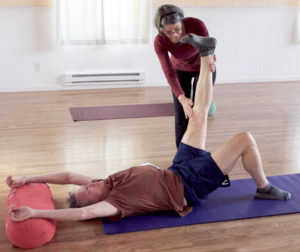
We bring nothing to our practice by letting go of preconceived notions both about ourselves and about the practice of yoga. This includes notions of what our bodies are supposed to look like, what they should be able to accomplish, what specific benefits should result from the practice of yoga and how long it should take to achieve these benefits. To bring nothing to our practice is to come to practice however it is that we are, just exactly as we are, and to come open to whatever it is that we may encounter, just exactly as it is that we may encounter it.
We bring everything to our practice by bringing to it our whole selves, both our bodies and our minds. What does it mean to bring our bodies into our yoga practice? How could we possibly not do that and still be practicing yoga? While it might seem self-evident that we bring our bodies to our practice simply by placing them on our yoga mats, in fact, there are a number of reasons why we may leave parts of the body behind when we practice including discomfort, fear and lack of awareness. We can also be so intent on fixing specific painful or injured parts of the body that we underestimate the importance of bringing the rest of the body into the practice as well.
What does it mean to bring our minds into our yoga practice? In the West, “mind” refers to that cognizing and rational part of our being which is absolutely essential to our functioning in so many ways, including in our yoga practice. This is the mind that enables us to comprehend the instructions given by the teacher and to direct our bodies to follow these instructions. It is this mind which enables us to recognize when we are confused by the instructions and gives us the ability to ask for clarification from the teacher. This is also the mind which enables us to recognize when we are distracted and to refocus our attention back on the practice.
While it is certainly not difficult to appreciate the absolute necessity of bringing our minds into our practice in this way, nevertheless, the English word “mind” does not capture the fullest understanding of what is meant by “mind” in both Hindu and Buddhist traditions. In both Sanskrit, the language of Hindu texts, and Pali, the language of Buddhist texts, the word for “mind” is “citta”, which might best be translated as “heart-mind”. In both of these ancient traditions, the heart and the mind are inextricably bound up with one another and it is this “heart-mind” which we must bring into our practice. This means that in addition to our cognizing and rational capabilities, we must also bring qualities of heart to our practice. We do this by meeting everything that we encounter, whether it is pleasant or unpleasant, expected or unexpected, not just in a spirit of acceptance, but in a spirit of actual friendliness. So whether it is a bodily sensation of painful joint stiffness or of blissful joint release, an emotion of profound sadness or of great joy, whether it is a thought which is insightful, judgmental or distracted, to bring “citta” to our practice is to receive all of these with the utmost kindness and care.
Bringing absolutely nothing and absolutely everything to our yoga practice is not such an easy task. That we do this imperfectly is not something to judge but rather something to understand. Cultivating our capacity to bring nothing and everything with greater constancy is both a practice in and of itself as well as an important part of the greater practice of yoga.
One of the most powerful tools for cultivating this capacity to bring both nothing and everything to our yoga can be the practice of setting an intention for ourselves at the beginning of each practice period or class. An intention is not be confused with a goal. The idea is not to set a benchmark and then judge our performance against that benchmark, but rather to use the setting of an intention to summon the capacities we need to go more deeply into our practice in order that it can be of greater benefit to us. We can set intention as we lie in our opening pose by extending to ourselves a simple wish that we bring our full body and heart-mind to the practice we are about to begin by letting go of any preconceived notions about what is supposed to happen and by meeting whatever it is that we may encounter with our sincere effort, our careful attention and with great kindness.
I invite you to explore the practice of setting an intention with the sincere wish that this be of benefit to you in your yoga practice.
Namaste,
Wendy
